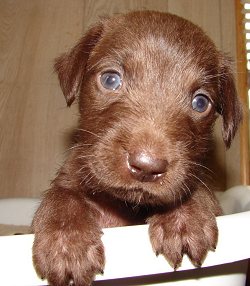Height: 22-26 inches
Weight: 45-70 lbs.
Life Span: 12-14 yrs.
Breed Group: Sporting Dogs
Overview
German wirehaired pointers are more aloof and wary of strangers than their
shorthaired cousins. They can be stubborn and easily distracted, making
obedience training a challenge.
While they are generally good with children, they should be introduced to
them at an early age. Early socialization with people and exposure to different
noises and places may help them to become more adaptable.
They can be aggressive with other dogs and protective of their property
but get along with other animals, such as cats, if raised with them.
Appearance
The distinctive outercoat is straight, harsh, wiry, one to two inches long,
and close-lying, and protects against rough cover, such as thorny bushes;
the undercoat is thick in winter and thin in summer.
Coat color is solid liver, liver and white, or liver and roan. There may
be spots, roaning, or ticking. Facial features include bushy eyebrows, a
medium-length beard and whiskers, and a large brown nose with wide-open
nostrils.
Grooming & Exercise Needs
The German wirehaired pointer needs to be brushed and combed twice a week.
This breed is only suitable for those who can give the dog vigorous, daily
exercise, such as long runs or jogs.
Origins
The Germans developed this breed in the 19th century for endurance and versatility--to
track, point, and retrieve all types of game in even the most difficult
terrain and weather conditions.
Special Alerts
This breed is not suitable for inexperienced dog owners or for city or apartment
living.
Reference: AKC - American Kennel Club |

